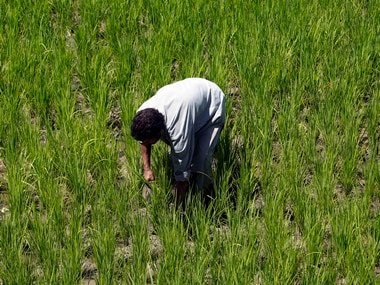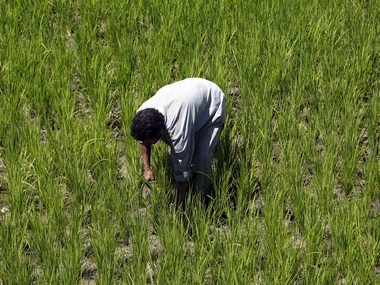By Chaitanya Mallapur Mumbai: In 2017-18, Karnataka’s agriculture sector received, on average, six hours of power per day — lowest among the states for which data were available — according to latest national data . With 70 percent of the state’s population dependent on agriculture, and 70 percent of the state’s cultivable land dependent on low and erratic rainfall, power supply for irrigation is crucial ahead of elections to the state’s assembly on 12 May 2018. Rural Karnataka, which accounts for 154 (69 percent) of the state’s 224 legislative constituencies, remains the primary focus of the election. Nearly 61 percent of Karnataka’s population lives in rural areas, and 54.6 percent of the state’s workforce is employed in agriculture and allied activities. Karnataka’s farmers are battling drought and water shortage, and have been under dire financial duress, with the state recording second highest number of farmer suicides in 2016, IndiaSpend reported on May 8, 2018. Uttarakhand, Odisha and Telangana saw nearly round-the-clock power supply to agriculture, according to Central Electricity Authority (CEA) of India’s March 2018 report . Poorer states such as Bihar and Chhattisgarh — at 18 hours a day — also fared better in supplying power to agriculture.
| Power Supply to Agricultural Sector In 2017-18, Selected States |
|---|
| State |
| Karnataka |
| Rajasthan |
| Andhra Pradesh |
| Gujarat |
| Tamil Nadu |
| Maharashtra |
| Haryana |
| Punjab |
| Bihar |
| Chhattisgarh |
| Uttar Pradesh |
| Jharkhand |
| West Bengal |
| Uttarakhand |
| Odisha |
| Telangana |
Source: Central Electricity Authority
In 2016-17, agriculture–specifically, water pumping through irrigation pump sets–accounted for 40 percent of the state’s power consumption, according to data from the Karnataka
Economic Survey 2017-18
. Domestic (22 percent) and industrial (14 percent) consumption followed. Irrigation — through pump sets — is imperative for the growth of the agricultural sector in the state, as 70 percent of cultivable land in Karnataka, as we said, is
dependent
on low and erratic rainfall. Between June and September 2017, cumulative rainfall
recorded
in Karnataka was 774 mm, as against a normal of 839 mm — a deficit of 8 percent with six districts falling under rainfall deficit category. “Overall, the state escaped from severe drought situation due to favourable rains during August, September and October 2017,” the economic survey noted. Tube/bore wells accounted for the 43 percent of the net irrigated area among all irrigational sources, followed by canals (29 percent ) and dug wells (12 percent percent). Power deficit drops, yet Karnataka continues to face shortages Karnataka’s installed power capacity rose 91 percent from
13,978 MW
in March 2014 to
26,697 MW
in March 2018. As of March 2018, Karnataka’s installed capacity accounts for 8 percent of India’s total capacity, up from 6 percent in 2014. [caption id=“attachment_4310577” align=“alignleft” width=“380”] Representational image. Reuters[/caption] Power generation in Karnataka declined 20 percent — from 46 billion units (BU) in 2015-16 to 37 billion units in 2016-17 — according to state’s
economic survey 2017-18
. One BU is enough to power 10 million
households
— one household consuming, on average, 3 units per day — for a month. “Karnataka state has been experiencing conditions of power shortage because of the ever-growing demand for power influenced by the rapid economic progress,” the states
Economic Survey 2017-18
said. The state meets its power shortage from neighbouring states. The growing demand and delay in completion of power generation projects in the state and central stations have led to increase power purchase from independent power producers, the
report
said. Power distress is visible in urban areas as well. The state’s capital, Bengaluru, is facing power outages for long hours with elections around the corner, the News Minute
reported
on 25 April, 2018. “Unless the government manages its companies in the power sector in professional manner, allows (Karnataka Electricity Regulatory Commission) KERC to function as per the Electricity Act, 2003, and promotes solar energy in mission mode, supplying power on 24X7 basis will remain a mirage in the state,” Bhamy V Shenoy, an energy expert
wrote
in Deccan Herald in January 2018. Karnataka’s energy deficit — difference between requirement and availability — was reported to be 362 million units (MU) in 2016-17, down 89 percent from 3.3 billion units (BU) in 2015-16. The state’s energy requirement and supply is expected to increase by 7 percent (71.5 BU) and 16 percent (77 BU), respectively, in 2017-18 over its previous year, indicating a surplus of nearly 6 BU. Karnataka’s peak power demand is expected to rise 9 percent from 10,261 megawatt (MW) in 2016-17 to 11,138 MW in 2017-18, according to CEA
data
. Peak power deficit — the difference between peak demand and peak supply — is expected to increase nearly 31 times (from 19 MW to 605 MW) over the same period. 100 percent villages electrified, but 6 percent rural households still lack access As of 1 April, 2015, Karnataka had 39 unelectrified villages, all of which have been electrified since, according to the Centre’s Grameen Vidyutikaran
dashboard
. Of these, only 31 percent or 12 villages have all households electrified.
Representational image. Reuters[/caption] Power generation in Karnataka declined 20 percent — from 46 billion units (BU) in 2015-16 to 37 billion units in 2016-17 — according to state’s
economic survey 2017-18
. One BU is enough to power 10 million
households
— one household consuming, on average, 3 units per day — for a month. “Karnataka state has been experiencing conditions of power shortage because of the ever-growing demand for power influenced by the rapid economic progress,” the states
Economic Survey 2017-18
said. The state meets its power shortage from neighbouring states. The growing demand and delay in completion of power generation projects in the state and central stations have led to increase power purchase from independent power producers, the
report
said. Power distress is visible in urban areas as well. The state’s capital, Bengaluru, is facing power outages for long hours with elections around the corner, the News Minute
reported
on 25 April, 2018. “Unless the government manages its companies in the power sector in professional manner, allows (Karnataka Electricity Regulatory Commission) KERC to function as per the Electricity Act, 2003, and promotes solar energy in mission mode, supplying power on 24X7 basis will remain a mirage in the state,” Bhamy V Shenoy, an energy expert
wrote
in Deccan Herald in January 2018. Karnataka’s energy deficit — difference between requirement and availability — was reported to be 362 million units (MU) in 2016-17, down 89 percent from 3.3 billion units (BU) in 2015-16. The state’s energy requirement and supply is expected to increase by 7 percent (71.5 BU) and 16 percent (77 BU), respectively, in 2017-18 over its previous year, indicating a surplus of nearly 6 BU. Karnataka’s peak power demand is expected to rise 9 percent from 10,261 megawatt (MW) in 2016-17 to 11,138 MW in 2017-18, according to CEA
data
. Peak power deficit — the difference between peak demand and peak supply — is expected to increase nearly 31 times (from 19 MW to 605 MW) over the same period. 100 percent villages electrified, but 6 percent rural households still lack access As of 1 April, 2015, Karnataka had 39 unelectrified villages, all of which have been electrified since, according to the Centre’s Grameen Vidyutikaran
dashboard
. Of these, only 31 percent or 12 villages have all households electrified.
A village is considered electrified if power is provided to at least 10 percent households and public places like schools, panchayat offices, health centres, dispensaries and community centres. Prime Minister Narendra Modi announced 100 percent electrification of all villages across the country on 28 April, 2018. However, this was contested as only 8 percent of the villages had all the households electrified, and more than 30 million households are yet to be electrified across the country. As of 7 May, 2018, of the 9.4 million rural households in the state, 94 percent (8.8 million) have been electrified, according to the Centre’s Saubhagya household electrification dashboard , while 580,376 households still lack access to electricity. The author is an analyst with IndiaSpend
)